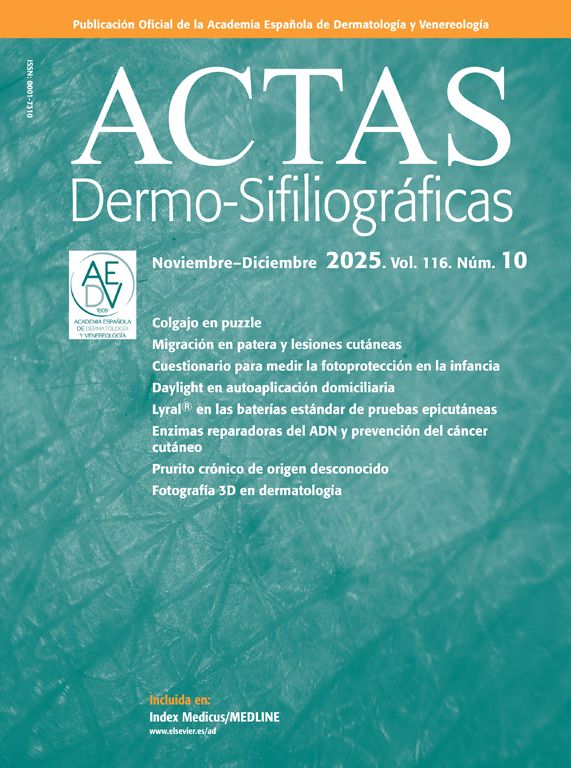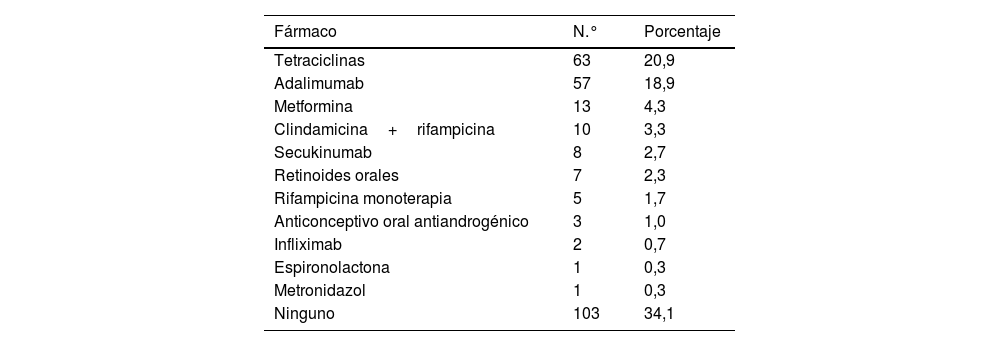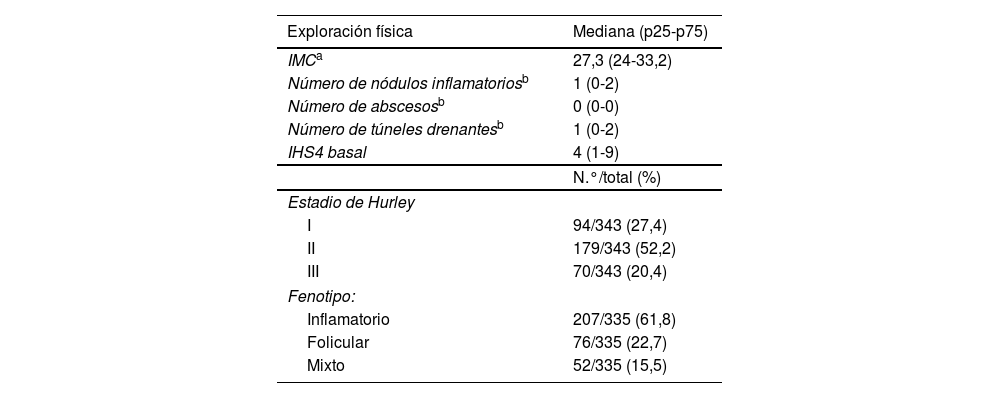La hidradenitis supurativa (HS) es una enfermedad que condiciona un gran impacto en la calidad de vida. Existen dudas sobre su epidemiología, historia natural y sobre la efectividad y la seguridad de los tratamientos existentes. La Academia Española de Dermatología y Venereología ha impulsado la creación de un Registro Español de pacientes con HS (REHS). El objetivo de este artículo es presentar el REHS y proporcionar los primeros resultados obtenidos.
MétodosEl REHS es un estudio observacional con medicamentos de seguimiento prospectivo, multicéntrico, que recoge las características clínicas y epidemiológicas de los pacientes con HS, así como la seguridad y la efectividad de los tratamientos médicos y quirúrgicos recibidos.
ResultadosEntre junio de 2023 y junio de 2024 se han recogido 359 pacientes de 23 centros españoles. La edad media de los pacientes es de 37 años, y un 53% son mujeres. Más del 70% de los pacientes son fumadores o exfumadores. Un tercio tiene antecedentes familiares de HS. Las localizaciones de inicio más frecuente de la enfermedad son axilas e ingles. La mediana de IHS4 basal al reclutamiento ha sido de 4 (p25-p75=1-9), la del HiSQOL de 20 (p25-p75=8-36), y el IMC de 27,3 (p25-p75=24-33,2). Al menos el 82% de los pacientes han recibido tratamientos antibióticos para su enfermedad, y casi un 20% un fármaco biológico.
ConclusionesPresentamos los datos de los primeros pacientes reclutados en el REHS, que permitirá generar evidencia sobre el curso natural de la enfermedad, así como la efectividad y la seguridad de los tratamientos en HS.
Hidradenitis suppurativa (HS) is a skin disease that significantly impacts patients’ quality of life. There are still uncertainties surrounding its epidemiology, natural history, and the safety and effectiveness of existing treatments. The Spanish Academy of Dermatology and Venereology has promoted the creation of a Spanish Registry of patients with HS (REHS). The aim of this article is to present the REHS and provide the initial results obtained.
MethodsThe REHS is a prospective, multicenter, observational study that collects the clinical and epidemiological characteristics of patients with HS, as well as the safety and effectiveness of the medical and surgical treatments received.
ResultsBetween June 2023 and June 2024, 359 patients were recruited from 23 Spanish centers. The average age of the patients is 37 years, and 53% of them are women. Over 70% of the patients are smokers or former smokers. One third have a family history of HS. The most frequent sites of disease onset are the axillae and groin. Median baseline IHS4 at recruitment was 4 (p25-p75=1-9), HiSQOL was 20 (p25-p75=8-36), and BMI was 27.3 (p25-p75=24-33.2). At least 82% of patients have received antibiotic therapy for their disease, and almost 20% a biologic drug.
ConclusionsWe present data from the first patients enrolled in the REHS, which will allow for the generation of evidence on the natural course of the disease, as well as the effectiveness and safety of treatments in HS.
La hidradenitis supurativa (HS) es una enfermedad crónica de la piel que se caracteriza por la formación de nódulos inflamatorios, abscesos y cicatrices en áreas como las axilas, las ingles y los glúteos1,2. Puede tener un profundo impacto en la calidad de vida, siendo una de las pocas enfermedades dermatológicas que se ha vinculado a un mayor riesgo de suicidio3.
Los datos actuales sobre la HS indican que su prevalencia varía según la región, siendo más común en países occidentales, donde estaría en torno al 0,4-1,7%. Por tanto, podría haber más de 500.000 pacientes afectos de esta enfermedad en España4. Se han identificado una posible predisposición genética para la HS5, y una asociación estrecha con el tabaquismo y la obesidad, pero la patogenia de la enfermedad todavía no es bien comprendida6.
La mayor parte de los casos de HS son leves y se tratan con fármacos tópicos o intralesionales7, además de ciclos de antibióticos sistémicos de duración variable. Sin embargo, las formas moderadas y graves siguen representando un gran reto terapéutico, y precisan asociar fármacos inmunomoduladores (corticoides sistémicos, biológicos, etc.) y cirugías de extensión variable8. Las guías de práctica clínica recomiendan el uso de múltiples fármacos9, pero la evidencia disponible sobre la eficacia y la seguridad de estos en los pacientes con HS, tanto en monoterapia como en combinación, sigue siendo muy limitada y los resultados clínicos insatisfactorios. Se ha hipotetizado que una intervención terapéutica precoz podría influir en el curso de la enfermedad10, pero la evidencia disponible al respecto es también, aún, muy limitada. Además, existen numerosas medidas de tratamiento tópico, educativas y de modificaciones en los hábitos de vida cuya eficacia no ha sido convenientemente probada2. Finalmente, el tratamiento quirúrgico de la HS es fundamental en algunos momentos de la enfermedad, existiendo diversas modalidades disponibles11. No obstante, no hay evidencia suficiente todavía de qué procedimientos son más eficaces y seguros en el tiempo, ni de cuál es el momento óptimo de intervenir, habiéndose planteado recientemente la posible existencia de una ventana de oportunidad terapéutica quirúrgica12.
El Registro Español de Hidradenitis Supurativa (REHS) es un proyecto promovido por la Academia Española de Dermatología y Venereología (AEDV) en colaboración con el Grupo Español de Hidradenitis Supurativa (GEHS), con el objetivo de aportar información clínica, epidemiológica y sobre la atención a los pacientes con HS en España, y de generar evidencia que permita dar respuesta a varias de las preguntas que han sido establecidas como prioritarias a nivel internacional sobre esta enfermedad. Los objetivos de este registro han sido considerados prioritarios por médicos y pacientes, ocupando puestos relevantes en la lista de las 10 prioridades de investigación en HS de la James Lind Alliance13, e incluyen: a) Describir la efectividad y la seguridad a corto y largo plazo de los tratamientos sistémicos para la HS; b) Evaluar si existen factores demográficos, socioeconómicos o clínicos que puedan predecir el pronóstico de la HS (qué pacientes van a progresar, y cuales no), c) Evaluar si un diagnóstico y tratamiento precoces de la enfermedad pueden influir en el curso de la enfermedad y d) Evaluar la eficacia y la seguridad de los distintos tipos de intervención quirúrgica empleados en el tratamiento de la HS.
El objetivo de este trabajo es describir el REHS, así como proporcionar los primeros datos descriptivos básicos de su primer año de funcionamiento.
Material y métodosEl REHS es un estudio observacional con medicamentos de seguimiento prospectivo. Se trata de una cohorte prospectiva multicéntrica, que incluye a los pacientes con HS de cualquier edad que reciben atención en una consulta de dermatología en España. Recoge las características sociodemográficas y clínicas de estos pacientes, así como la seguridad, la efectividad y el impacto en la calidad de vida de los tratamientos recibidos. En relación con los datos sociodemográficos, el registro incluye información sobre la dirección aproximada del paciente que se obtiene del portal de CartoCiudad del gobierno de España14, lo cual permitirá extraer su sección censal de residencia y ajustar por datos del censo como el nivel socioeconómico. También se podrá disponer de información sobre el tipo de residencia (urbana / rural), mediante técnicas de análisis espacial15. Además, el estudio ofrece a los pacientes la posibilidad de participar en ensayos clínicos empleando un diseño ensayo/cohorte16, y recibió la aprobación del Comité de ética de la investigación con medicamentos del Hospital Universitario y Politécnico La Fe en marzo de 2023 (FAE-HS-2023-01, Acta n.° 543).
Los datos se recogen y gestionan mediante la herramienta de captura electrónica de datos Research Electronic Data Capture (REDCap)17. Para participar en el REHS, es necesario que los centros participantes cuenten con al menos un dermatólogo con interés y responsabilidad en la supervisión y tratamiento de los pacientes con HS, tener una organización en el servicio que permita poder incluir a todos los pacientes que se vean con esta enfermedad y se debe ver un volumen mínimo de 10 nuevos pacientes al año que puedan ser candidatos para incluir en el estudio. Los criterios de inclusión de los pacientes son: pacientes con HS que son valorados en una consulta de dermatología en España, y diagnóstico de HS por parte de un dermatólogo, acorde con los criterios clínicos de Dessau18.
El registro cuenta con: a) una visita de inclusión, en la que se recogen los datos demográficos y clínicos del paciente, sus antecedentes, una exploración física básica con datos que permiten el cálculo automatizado del IHS4 y el cuestionario de calidad de vida HiSQOL basal, b) un formulario de situación del paciente, que recoge información sobre las fechas de ocurrencia de diversos hitos de la enfermedad durante la vida del paciente, c) un formulario de tratamientos, que recoge información tanto sobre los tratamientos sistémicos (que debe cumplimentarse al reclutamiento y siempre que el paciente inicie un nuevo fármaco, e incluye un campo de acontecimientos adversos graves) y otro de tratamientos quirúrgicos; d) visitas de seguimiento, que se realizan según lo programado en la práctica clínica habitual, y que incluyen exploraciones físicas de seguimiento básicas con evaluación del IHS4 y el cuestionario de calidad de vida HiSQOL de seguimiento. HiSQOL es el cuestionario de calidad de vida desarrollado por HISTORIC19, la alianza internacional para establecer medidas de resultado que permitan mejorar la calidad y la consistencia de los estudios que evalúan los tratamientos en HS. HiSQOL contiene 17 ítems de 3 subdominios (síntomas, psicosocial y adaptaciones de la actividad), recoge información sobre los 7 días previos, y es el cuestionario de vida actualmente recomendado a nivel internacional en HS20.
Este trabajo incluye algunos datos descriptivos de las características demográficas y clínicas del paciente en el momento de la inclusión, así como de sus antecedentes. Incluye también información sobre la situación en la primera visita. Estas variables se han compilado en índices según la naturaleza de la variable (media y desviación típica o mediana y p25-p75 para variables numéricas según se ajusten o no a una distribución normal, y frecuencias y porcentajes para variables cualitativas).
ResultadosEn junio de 2024 el registro contaba con 359 pacientes de 23 centros hospitalarios en todo el territorio español, con representación de 21 provincias. En cuanto a la distribución por sexo, 190 (52,9%) son mujeres y 169 varones, con una edad media de 37,4 años (rango: 11,7-74,3). La tabla 1 presenta las características clínicas de los pacientes.
Características demográficas y clínicas de los pacientes del Registro Español de Hidradenitis Supurativa en su primer año de funcionamiento
| Variable | N.°/total (%) |
|---|---|
| Sexo: mujer | 190/359 (52,9) |
| Edad inclusión, en años (media [DE]) | 37,4 (14,4) |
| Edad al diagnóstico de HS* (mediana [p25-p75]) | 29,8 (20,5-43,3) |
| Antecedentes familiares de primer grado HS: Sí | 121/341 (35,5) |
| Localización anatómica de la primera lesión tratada, N=359 | N.° (%) |
|---|---|
| Axilar | 77 (21,4) |
| Inguinal | 75 (20,9) |
| Sacra-glútea | 47 (13,1) |
| Genital-periné | 32 (8,9) |
| Cabeza y cuello | 19 (5,3) |
| Muslos | 6 (1,7) |
| Sub o intermamaria | 6 (1,7) |
| Abdomen | 1 (0,3) |
| Desconocida | 96 (26,7) |
| Comorbilidades | N.°/total (%) |
|---|---|
| HTA: Sí | 48/356 (13,5) |
| Diabetes: Sí | 42/356 (11,8) |
| Dislipemia: Sí | 49/356 (13,8) |
| Acné: Sí | 105/354 (29,7) |
| Ansiedad: Sí | 91/351 (25,9) |
| Depresión: Sí | 43/344 (12,5) |
| Insomnio: Sí | 33/342 (9,6) |
| Enfermedad inflamatoria intestinal: Sí | 7/349 (2,0) |
| Artritis: Sí | 17/355 (4,9) |
| Tabaquismo | |
| Fuma actualmente | 201 (56,0) |
| Exfumador | 55 (15,3) |
| Nunca ha fumado | 99 (27,6) |
| Desconocido | 4 (1,1) |
| Tratamientos previos realizados | N.°/total (%) |
|---|---|
| Médicos: Antibióticos sistémicos: Sí | 293/357 (82,1) |
| Corticoides intralesionales/orales: Sí | 99/341 (29,0) |
| Retinoides orales: Sí | 56/340 (16,5) |
| Fármacos biológicos: Sí | 65/337 (19,3) |
| Número de biológicos realizados (media, DE) | 1,3 (0,6) |
| Quirúrgicos: Sí | 193/338 (57,1) |
DE: desviación estándar; HS: hidradenitis supurativa; HTA: hipertensión arterial
Las localizaciones anatómicas más frecuentes que precisaron algún tipo de tratamiento en primer lugar fueron las axilas (21,4%) y las ingles (20,9%). Un tercio de los pacientes tiene antecedentes de primer grado de HS. Más de la mitad (56%) son fumadores y el 15,3% son exfumadores. Las comorbilidades más frecuentes son acné (29%), ansiedad (25,9%) y dislipemia (13,8%). Algo más de la mitad de los pacientes (53,8%) habían precisado algún tratamiento quirúrgico para su HS antes de la inclusión en el registro, el 82,1% habían realizado al menos algún tratamiento antibiótico, y casi un tercio habían recibido corticoides sistémicos o intralesionales (tabla 2). El 25,9% estaban tomando o iniciaron antibióticos en el momento de la visita de inclusión, y el 22,3% tratamiento biológico.
Tratamientos sistémicos activos en la visita de inclusión (N=301)
| Fármaco | N.° | Porcentaje |
|---|---|---|
| Tetraciclinas | 63 | 20,9 |
| Adalimumab | 57 | 18,9 |
| Metformina | 13 | 4,3 |
| Clindamicina+rifampicina | 10 | 3,3 |
| Secukinumab | 8 | 2,7 |
| Retinoides orales | 7 | 2,3 |
| Rifampicina monoterapia | 5 | 1,7 |
| Anticonceptivo oral antiandrogénico | 3 | 1,0 |
| Infliximab | 2 | 0,7 |
| Espironolactona | 1 | 0,3 |
| Metronidazol | 1 | 0,3 |
| Ninguno | 103 | 34,1 |
Los datos relativos a la exploración física basal se encuentran en la tabla 3. En la visita inicial, la gravedad media de la HS medida por IHS4 fue de 7,8, con una mediana de 4 (p25-p75: 1-9). En un 61,7% de los pacientes se empleó la ecografía cutánea para el recuento de nódulos inflamatorios, abscesos y túneles. Aproximadamente la mitad (52,5%) de los pacientes tienen Hurley II, y un 20% un Hurley III. En relación con la calidad de vida, la puntuación media del HiSQOL basal fue de 23,3 puntos.
Exploración física y calidad de vida a la inclusión (N=359)
| Exploración física | Mediana (p25-p75) |
|---|---|
| IMCa | 27,3 (24-33,2) |
| Número de nódulos inflamatoriosb | 1 (0-2) |
| Número de abscesosb | 0 (0-0) |
| Número de túneles drenantesb | 1 (0-2) |
| IHS4 basal | 4 (1-9) |
| N.°/total (%) | |
| Estadio de Hurley | |
| I | 94/343 (27,4) |
| II | 179/343 (52,2) |
| III | 70/343 (20,4) |
| Fenotipo: | |
| Inflamatorio | 207/335 (61,8) |
| Folicular | 76/335 (22,7) |
| Mixto | 52/335 (15,5) |
| Calidad de vida | Mediana (p25-p75) |
|---|---|
| HISQOL BASAL (0-68)c | 20 (8-36) |
IMC: índice de masa corporal.
En su primer año de funcionamiento, se han incluido en el REHS 359 pacientes de 23 centros participantes, con un amplio rango de edad (11-74 años), y una proporción similar de varones y mujeres. Estos datos obtenidos en solo un año son esperanzadores de cara a que el REHS pueda lograr una buena representatividad de los pacientes con HS que reciben atención en las consultas de dermatología en España.
En cuanto a las características clínicas, preocupa el alto porcentaje de fumadores y exfumadores entre los pacientes del REHS (en total el 71,3 vs. 51,1% en la población general española)21, dado que, además de las complicaciones de salud asociadas al tabaquismo, varios estudios han demostrado que también predispone al desarrollo de una enfermedad más grave5,9. Además, la mediana de IMC fue de 27,3 (sobrepeso), y más de un 10% de los pacientes, a pesar de ser jóvenes, tienen HTA y/o diabetes y/o dislipemia, por lo que el riesgo cardiovascular de los pacientes podría ser elevado22.
Existen diversas iniciativas de registros de los pacientes de HS23, pero muy pocos estudios de población prospectivos semejantes al REHS, y son todavía más escasos los que han presentado ya algunos resultados24–26. El registro escandinavo HISREG arrancó en 2012, y logró reclutar 225 pacientes en sus primeros 3 años de funcionamiento26, empleando las escalas de Hurley, Sartorius, NRS de dolor y DLQI, pero no el IHS4 ni el HiSQOL, por el momento en que fue desarrollado. En 2019 publicaron sus últimos datos hasta el momento de escribir esta publicación, en que evaluaron los tratamientos empleados en sus 3 primeros años de funcionamiento (2013-2016)26, no contando entonces ningún paciente con tratamiento biológico (adalimumab, el primer biológico con indicación para HS, fue autorizado en 2016). También han existido 2 registros italianos, logrando reclutar el segundo (IRHIS 2) 991 pacientes entre 2015 y 2019, pero se trata de cortes transversales sin seguimiento posterior27. Desde 2015 existe un Registro Europeo de pacientes con HS con el objetivo de conocer mejor la enfermedad y su evolución, la asociación con comorbilidades y de evaluar la eficacia de los tratamientos disponibles28, habiendo sido publicados hasta el momento los resultados de la sección belga de este registro, con 606 pacientes reclutados en casi 10 años29. En relación con las escalas de exploración física, cabe destacar una distribución similar en la escala de Hurley de los pacientes del REHS y de los del registro belga, salvo por un porcentaje de estadios III ligeramente superior en el REHS (15 vs 20%), y de forma concordante un IHS4 promedio superior en los pacientes del REHS (7,8; DE: 11,4) frente a los pacientes del registro belga (5,2; DE: 12,3). Esto podría explicarse por una afectación más grave de los pacientes del REHS, o por el elevado porcentaje de uso de la ecografía en la medición de IHS4 detectado dentro del REHS (en 61,7% de los pacientes), que podría haber conllevado un aumento en las puntuaciones de las escalas con respecto a la observación meramente clínica30, dado que la ecografía permite evaluaciones más precisas y una mejor identificación de los túneles, que son los que más puntúan en la escala IHS4. Cabe destacar que los pacientes del REHS presentan datos parecidos al registro belga en cuanto a antecedentes familiares de HS, tabaquismo y edad media de reclutamiento, y ciertas diferencias en cuanto a datos demográficos, con mayor proporción de mujeres en el registro belga (67%), así como de ciertas comorbilidades, con una mayor proporción de depresión en el registro belga (siendo su mayor comorbilidad detectada) con un 43,8% y de EII con un 7,7%, vs 12.5% y 2% respectivamente en el REHS, siendo más frecuente entre los pacientes del REHS la ansiedad (25,9%), no recogida como comorbilidad en el registro belga.
El REHS ha logrado incluir a más de 350 pacientes en su primer año, demostrando una gran capacidad de reclutamiento, y los pacientes están en seguimiento activo. Otras fortalezas del REHS son: por un lado, incluye un diseño trial-cohort, que permitirá evaluar la eficacia de intervenciones no farmacológicas, mediante la aleatorización entre grupos dentro del registro. Este diseño podría ser de especial interés para evaluar, por ejemplo, medidas que demuestren eficacia para deshabituación tabáquica, antes de escalarlas a nivel nacional, con el fin de mejorar los resultados en salud de los pacientes con HS. Por otro lado, el REHS es actualmente el único registro de pacientes con HS que cuenta con la combinación de medidas validadas de resultados IHS4 e HiSQOL, por lo que podrá proporcionar datos relevantes en este sentido y permitir comparaciones con datos de los ensayos clínicos actualmente en curso. Cabe destacar que la puntuación media del HiSQOL ha sido de 23,3 puntos (afectación grave), tan solo 2 puntos inferior a la media de pacientes incluidos en ensayos clínicos de HS de fase 321. Por último, el REHS recoge datos de intervenciones quirúrgicas y permitirá valorar la efectividad de tratamientos combinados médicos y quirúrgicos.
Publicaciones recientes sugieren que el tratamiento precoz en los pacientes con HS podría disminuir las complicaciones derivadas de esta31. Sin embargo, la evidencia sobre la eficacia de estas intervenciones es todavía muy limitada32, y uno de los principales objetivos del REHS es precisamente evaluar si un diagnóstico y tratamiento precoces de la enfermedad pueden influir en su curso. Un cuarto de los pacientes del REHS a la inclusión están tomando antibiótico y un 22,3% un tratamiento biológico. En los datos disponibles del registro escandinavo, ningún paciente había sido tratado con biológicos26, y ni en el italiano IRHIS 2 ni en el belga se ha mostrado todavía información relativa a los tratamientos27,29, por lo que el REHS se posiciona favorablemente para poder evaluar en el futuro respuestas a fármacos tanto en monoterapia como combinadas, y potencialmente la progresión de la enfermedad.
En conclusión, presentamos los datos del primer año de funcionamiento del REHS. Hasta este momento contamos con pacientes de 23 centros diferentes a lo largo de todo el territorio español y más de 350 pacientes, con un ritmo creciente de inclusión. El REHS ha logrado un reclutamiento destacable en poco tiempo, y cuenta con herramientas de resultado validadas a nivel internacional tanto en exploración física como en calidad de vida. Aspira a describir las características clínicas y epidemiológicas de los pacientes con HS en España y evaluará la seguridad, efectividad e impacto en la calidad de vida de los tratamientos médicos y quirúrgicos incluidos en las guías de práctica clínica de esta enfermedad.
FinanciaciónEl REHS está promovido por la Fundación Piel Sana de la Academia Española de Dermatología y Venereología (AEDV) y recibe financiación de las compañías farmacéuticas Novartis y UCB Pharma. Ninguna de estas empresas ha participado en el diseño o realización del estudio; en la recogida, gestión, análisis o interpretación de los datos; en la preparación, revisión o aprobación del manuscrito; ni en la decisión de enviar este manuscrito para su publicación.
Conflicto de interesesJ. Garcias-Ladaria ha recibido ayuda para asistir a congresos de Novartis y UCB, ha sido ponente para Novartis y ha participado en Advisory board para Novartis.
J. Bassas Vila ha recibido honorarios de Abbvie, Novartis y UCB para realizar conferencias, subvencionar su formación continuada, participar en advisory boards y asistir a jornadas y congresos.
L. Salgado-Boquete ha colaborado con las siguientes compañías farmacéuticas como investigadora, asesora o ponente: Abbvie, Almirall, Amgen, Biogen, Boheringer, BMS, Celgene, Janssen-Cilag, Leo Pharma, Novartis, Sandoz, MSD-Schering-Plough, Lilly y UCB.
R. Rivera ha participado en asesorías, como ponente, como investigadora y ha recibido ayuda para asistir a congresos de los Laboratorios Abbvie, Boehringer, INCYTE, Johnson & Johnson, Novartis y UCB.
G. Martín-Ezquerra ha recibido honorarios de Advisory de Novartis y UCB pharma.
E. Vilarrasa ha recibido honorarios como consultor/ponente y/o ha participado en ensayos clínicos patrocinados por Abbvie, Almirall, Amgen, Bayer, Biofrontera, Boehringer Ingelheim, Bristol-Myers Squibb, Celgene, Galderma, Gebro, Isdin, Janssen, Leo-Pharma, Lilly, Merck-Serono, MSD, Novartis, Pfizer, Roche, Sandoz, Sanofi y UCB.
L.M. Pericet Fernández ha colaborado como ponente para Abbvie y Novartis.
I. Gracia-Darder ha recibido honorarios como ponente y/o ayudas para viajes para asistir a reuniones y/o ha participado en ensayos clínicos patrocinados por Almirall, Amgen, Cantabria Labs, Cumlaude lab, Isdin, Janssen, LEO Pharma, Lilly, Loreal, Novartis, Pfizer, Pierre Fabre, Sanofi, SVR y UCB.
V. Mora-Fernández ha recibido honorarios como ponente de charlas, advisory board, por la participación en ensayos clínicos, así como ayuda para la asistencia a congresos y cursos por parte de AbbVie, Janssen, Novartis Pharma, Sanofi, LEO pharma, Isdin, Galderma y UCB Pharma.
M. Grau-Pérez ha recibido ayudas para desplazamiento y formación en congresos científicos de Abbvie, Janssen, Novartis, Pierre Fabre, Sanofi y UCB Pharma.
A. Martorell ha recibido honorarios y/o subvenciones para viajes y/o ha actuado como miembro de consejos asesores para Novartis, AbbVie, Janssen Cilag, UCB, Lilly, LEO Pharma, L’Oreal, Sanofi, Boehringer Ingelheim, Almirall, Bristol Myers Squib y Amgen. También ha trabajado como investigador principal en ensayos clínicos financiados por AbbVie, UCB, Jansen, Bristol Myers Squibb, Lilly, Galderma, Sanofi, Novartis y Legit Health.
A todos los investigadores del REHS, por realizar un esfuerzo adicional en la práctica clínica con la recogida de datos, así como a los pacientes y/o representantes legales por acceder a su inclusión en el registro correspondiente.
Jorge Arroyo (Hospital Universitario 12 de Octubre); Julia Verdaguer-Faja (Hospital Universitari Germans Trías i Pujol); Sandra Martínez Fernández (Complejo Hospitalario Universitario de Pontevedra); Manuel Sánchez-Díaz, Carlos Cuenca Barrales y Sofía Haselgruber (Hospital Universitario Virgen de las Nieves); Marta Ruano del Salado (Hospital Universitario de Torrejón); Begoña Udondo Gonzalez del Tanago (Hospital Universitario de Cruces); Alejandra Tomás y Francisco Javier García-Martinez (Clínica Universidad de Navarra); Antonio Sahuquillo Torralba y Rafael Botella (Hospital Universitario y Politécnico La Fe); Pedro Jose Navarro Guillamón (Hospital Universitario Virgen de la Victoria); Rubén Fuentes García (Hospital Universitari de la Santa Creu i Sant Pau); Irene Fuertes y Priscila Giavedoni (Hospital Clínic); Elena de Jesús García Verdú, Paola Merlo Gómez, Sonsoles María Aboín González y Lidia Trasobares (Hospital Universitario Príncipe de Asturias); María Elena Pelegrina Fernández, José González Rodríguez y Eduardo de la Rosa Fernández (Hospital Universitario Nuestra Señora de Candelaria); Paula Dávila Seijo (Hospital do Meixoeiro) e Ignacio García-Doval (Unidad de Investigación AEDV). El REHS se ha desarrollado dentro del Grupo Español de Hidradenitis Supurativa (GEHS).







